Abies concolor
White Fir
White Fir is heat and drought tolerant. Accepts sandy to heavy clay soils. Long, attractive needles. Canopy coverage: 314 square feet.
[Read More]Acer ginnala
Amur Maple
One of the appealing features of Amur Maple is its brilliant fall color. Multiple trunks make it useful as a screen. It does require well draining soil. Canopy coverage: 314 square feet.
[Read More]Acer glabrum
Rocky Mountain Maple
Rocky Mountain Maple can be grown as a tree or shrub, but is much more common as a large, multitrunked, wide-spreading shrub. Allow plenty of room for rampant growth. Leaves are deeply serrated, and often host red galls. Yellow fall color. Accepts most soils. Canopy coverage: 79 square feet.
[Read More]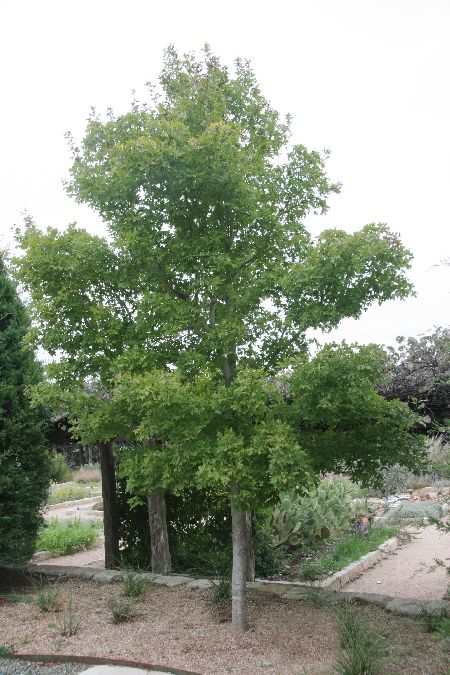
Acer grandidentatum
Bigtooth Maple, Wasatch Maple
Bigtooth Maple can be grown as tree or shrub. Trunk is short with a rounded crown. Leaves turn red and yellow in fall. Canopy coverage: 314 square feet.
[Read More]Acer negundo
Box Elder
This is a Maple for tough conditions of drought and heat. Identify by its compound leaves, unlike other Maples. Box Elder has its faults. It has a wide-spreading form but branches tend to break easily with strong winds. Reseeds and suckers readily. Look for 'Sensation', a male selection that does not reseed, does not sucker and has better branching structure. It has red fall color. Canopy coverage: 1,257 square feet.
[Read More]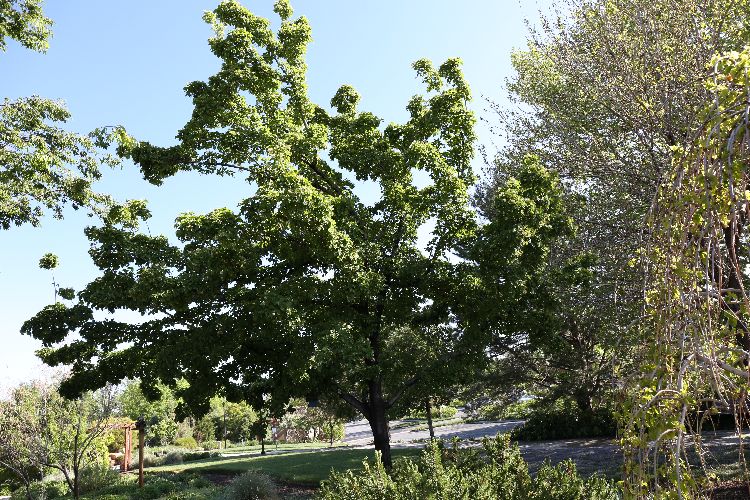
Acer tataricum
Tatarian Maple
Tatarian Maple is a small tree with a well-behaved form, useful as street tree. Summer color is provided by seeds followed by yellow and red fall color. 'Hot Wings' is an improved selection and a Plant Select introduction. Accepts sandy to heavy clay soils. Canopy coverage: 491.
[Read More]Aesculus hippocastanum
Horse Chestnut
Horse Chestnut produces spectacular white flowers in early summer. It accepts sandy to clay soils and nutritionally poor soils as long as it is well drained. Produces deep shade. Branches may break in the wind. Canopy coverage: 1,257 square feet.
[Read More]Alnus tenuifolia
Thinleaf Alder
This tree has an upright oval form. Native to riparian (streamside) environments, so it is adapted to grow in moist or wet soils. Accepts loam to clay soils. Can be shortlived. Canopy coverage: 314 square feet.
[Read More]Amelanchier x grandiflora
Apple Serviceberry
Apple Serviceberry is grown for its colorful flowers, fruit and orange-red fall color. Another appealing feature is its reddish to black, blueberrylike fruit, which are tasty and make a wonderful jam. Wide-spreading branches. Canopy coverage: 491 square feet.
[Read More]Amelanchier canadensis
Shadblow Serviceberry
Grow as a large shrub or train as a tree. Ideal for a casual, natural effect. Upright and rounded form. Attractions include the fragrant flowers and yellow, orange and red fall color. Berries emerge as green then turn red then black. They are edible and used for jams and preserves.
[Read More]Catalpa speciosa
Western Catalpa
Western Catalpa produces an irregular crown, and is somewhat pyramidal in form. Leaves are large, coarse textured, shaped like hearts, and susceptible to damage in strong winds. Flowers are followed by long seedpods up to 18 inches long. Accepts sandy to loam soils, tolerates clay soils. Canopy coverage: 1,257 square feet.
[Read More]Celtis occidentalis
Western Hackberry
Adapted to grow in a wide range of climates, Western Hackberry is also known as Common Hackberry. Grows as a large shrub or tree—give it more water for tree form. Best to plant from containers rather than bare root for better establishment. Yellow fall color and small red to purple fruit are attractions. Canopy coverage: 1,963 square feet.
[Read More]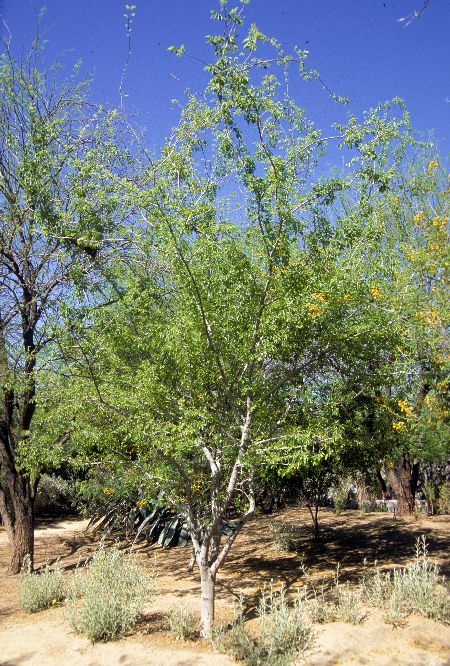
Celtis reticulata
Canyon Hackberry
The knobby gray bark of Canyon Hackberry is an interesting feature. Birds are attracted to the orange summer berries. Produces allergenic pollen. Canopy coverage: 491 square feet.
[Read More]Cercis canadensis
Eastern Redbud
Eastern Redbud is an attractive small tree for home landscapes. Flowers appear early in spring on bare branches, even before the leaves emerge. Yellow fall color. Selections with different flower colors are also available. Accepts sandy to loam soils; prefers moist soil but not soggy. Requires protection from winter temperatures in coldest regions. Canopy coverage: 707 square feet.
[Read More]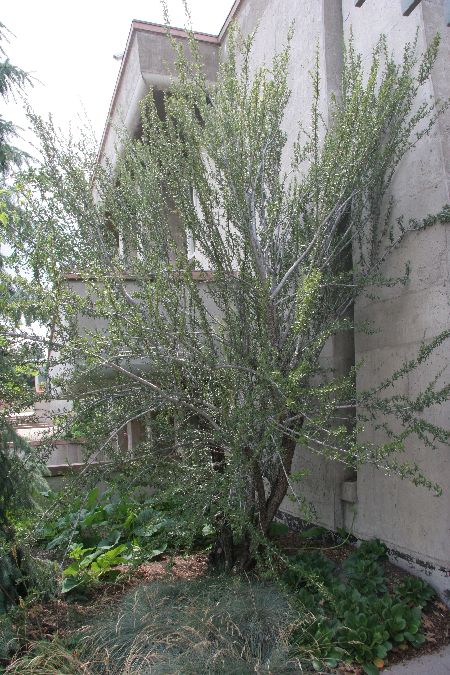
Cercocarpus ledifolius
Curl-leaf Mountain Mahogany
Curl-leaf Mountain Mahogany makes a suitable background plant. It can be trained to become a small tree to show off its rich, reddish brown bark. The small white flowers remind one of roses. Plant in well drained soil. Best with some protection from the sun in hot summer regions. Canopy coverage: 79 square feet.
[Read More]Cornus kousa
Japanese Dogwood
Japanese Dogwood are not particularly heat or drought tolerant, so are a little more challenging to grow successfully. Branching is horizontal with large, dense, lustrous leaves. Flowers are white, large and showy, followed by scarlet or yellow fall color. Needs a moist rich soil that isn't too heavy. Many improved selections are available—check availability locally. Canopy coverage: 314 square feet.
[Read More]Cornus mas
Cornelian Cherry Dogwood
Cornelian Cherry Dogwood is often grown as a shrub but can be trained to become a small tree. Early bloomer—flowers appear on bare stems before leaves emerge. Red berries are edible and used to make preserves—if you can harvest them before the birds. Yellow or red fall color. Accepts sandy to heavy clay soils; prefers moist soil. Canopy coverage: 314 square feet.
[Read More]Cotinus coggygria
Smoke Tree
Smoke Tree is a tree or shrub grown for its colorful foliage rather than flowers. The interesting "flower puffs" are actually faded flowers. Fall color in shades of yellow and orange is an attraction. 'Royal Purple' is a popular selection; additional selections are available with foliage in different colors. Best with some protection from the sun in hot summer regions. Canopy coverage: 177 square feet.
[Read More]Crataegus ambigua
Russian Hawthorn
Russian Hawthorn is admired for its dense, twisting branches and white flowers. Blooms are followed by profuse amounts of cherrylike fruits loved by birds. Yellow to orange fall color. Accepts sandy to heavy clay soils. Canopy coverage: 314 square feet.
[Read More]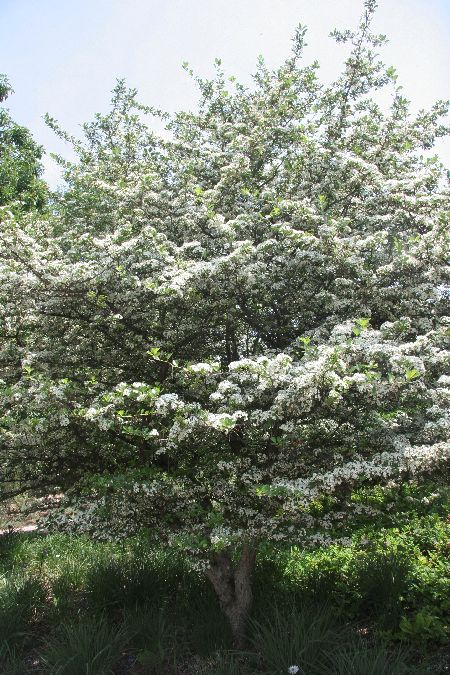
Crataegus crus-galli
Cockspur Hawthorn, Cockspur Thorn
Cockspur Hawthorn has a broad, rounded crown with horizontal branching. Sturdy thorns make it an excellent barrier and security plant. If you don't want thorns, look for plants labeled as 'Inermis'. Dark green leaves have a glossy sheen. White summer flowers are followed by small reddish fruit in fall. Attractive orange-red fall color. Accepts sandy to heavy clay soils. Canopy coverage: 962 square feet.
[Read More]Crataegus crus-galli inermis
Thornless Cockspur Hawthorn
Thornless Cockspur Hawthorn has a broad rounded crown with horizontal branching. Inermis (also 'Inermis') means it has no thorns. Dark green leaves have a glossy sheen. White summer flowers are followed by small reddish fruit in fall. Attractive orange-red fall color. Accepts sandy to heavy clay soils. Canopy coverage: 962 square feet.
[Read More]